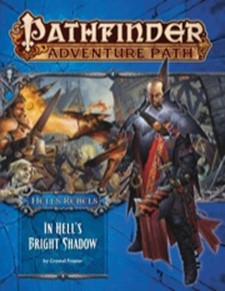 A couple of years ago, I ran the Council of Thieves Adventure Path for Pathfinder. It was the first of the adventure paths to be released using the full Pathfinder system rather than 3.5E, and although it had a great overall story and some memorable encounters, I had a lot of problems with the adventures: a lot of underpowered foes and some really badly written adventures. (I didn’t run it when it was new, but rather in 2013 once Pathfinder had been around for a while. It was a Core Book-only game, though).
A couple of years ago, I ran the Council of Thieves Adventure Path for Pathfinder. It was the first of the adventure paths to be released using the full Pathfinder system rather than 3.5E, and although it had a great overall story and some memorable encounters, I had a lot of problems with the adventures: a lot of underpowered foes and some really badly written adventures. (I didn’t run it when it was new, but rather in 2013 once Pathfinder had been around for a while. It was a Core Book-only game, though).
That campaign was set in the devil-loving nation of Cheliax. Now, Paizo have returned to that nation for a pair of complementary adventure paths; one for the forces of good, the other for the forces of evil – and will be the first Paizo AP to be written for evil characters. (We played through some of Way of the Wicked, a 3rd-party evil campaign for PF, but were forced to abort due to the players becoming unavailable to play).
In Hell’s Bright Shadow is the first of the Hell’s Rebels adventure path, and is set in the city of Kintargo, where the local Lord Mayor is attempting to emulate the proclamations of Curse of Xanathon: proclamations that seem ill-considered and possible actually insane, and that are moving the populace towards revolution. Unlike Curse, In Hell’s Bright Shadow is competently written, with flashes of brilliance.
I’ve got to admire an adventure that can kill the players in the first encounter if they insist on being stupid. When you’re first level and the authorities want to kill you, do you stay and fight? The ones that insist on staying are the ones who won’t be participating further in this adventure path!
Actually getting the players onto the plot of the adventure path is a little clumsy (they need to rescue someone, but might not be in a state to help based on the previous encounter), but once they get there they’ll soon find themselves at the core of the gathering rebel group against the Lord Mayor. This will probably escalate further! There are rules for tracking the rebellion in a free supplement, but I really can’t be bothered reading them. You can run the adventure without them, and given how tedious most of these subsystems tend to be (a lot of tracking information for not much pay-off), I’d rather just handwave them based on player actions.
The second part of the adventure consists of a number of missions the characters can go on to gather support for the rebellion, and events that occur as time passes. Most of the missions are fairly small in scale, but are likely to require some additional work from the DM to make them properly memorable. It’s not like they’re underwritten – there’s a lot of text in this adventure – but due to the wide variety of player actions, the adventure can only offer hints rather than a concrete plan of action.
There’s some excellent encounters here, especially the ones that draw on the work of some particularly demented Pathfinder designers. Who came up with the Tooth Fairies, and had they been reading Pratchett?
I am conflicted about the amount of text used to describe the backgrounds of what are really quite minor characters who may only see (and not survive) a short combat. There’s a lot of it that generally won’t be relevant, but, on the other hand, it gives material for GMs who want to bring even more story, context and role-playing into the adventure. So, while I think that it’s useless to me, I know there are people who will very much enjoy the extra details given for these encounters.
The final part of the adventure finds the players exploring an old Theatre/House of Horrors/Fantasmagorium. It’s a place with a lot of weird exhibitions, a number of which could be quite dangerous to the party. Their hope is that they’ll find allies in the location, but this may not come to pass. This section is really nice, providing rising tension between the expectation of the players and what they actually find. It also doesn’t seem to be too big: a party of 3rd-level characters could quite possibly explore it without resting, a pacing detail that I prefer. (I hate overlong dungeons!)
In Hell’s Bright Shadow is a solid adventure. There are a couple of encounters that I dislike, but mostly they’re of good quality. I do feel that you need a good DM to properly run this material: there’s likely to be a lot of role-playing and event management involved. I wouldn’t say it’s one of the classics, but it’s a good start to the Hell’s Rebels adventure path – and I’m not left wondering at the logic behind the plot. That’s got to be a good sign!
